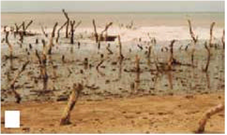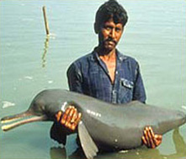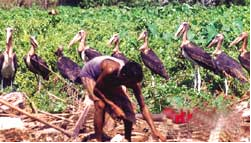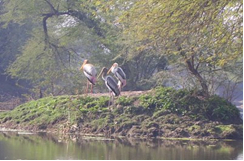India is facing a water crisis in nearly all the sectors. Fortunately or unfortunately, measures taken by the related authorities to combat the crisis often depends on the amount of 'noise' made by the relevant stakeholders. It is no wonder then, that the urban India, and especially the rich and the powerful in urban India, seldom have to face problems related to water scarcity, water quality or the sheer inequity in distribution. On the other hand, weaker the stakeholder, more severe are his ( rather 'her') problems. Marginal farmers, tail enders in a canal network, rural and urban poor, especially children and women, stand testimony to this situation. We all agree to this, right? 
Godavari delta, destruction of mangroves
But aren't we forgetting the the weakest, and in some ways, the strongest, of all the stakeholders? How about the ecosystem of the river itself?? Are we ready to acknowledge the ecosystem as an equal stakeholder in the fight for water? Are we ready to rethink the current water allocation scenario and allocate water for the riverine ecosystem and for the subsystems that depend on the river? Are we ready to accept the fact that water going to the sea is not a waste.. it is how a river should be... Current situation shows that we are evidently not ready for anything of this sort.. Let us look at some examples. In case of river Krishna, historically( before 1960s), the outfalls to the ocean averaged 57 BCM ( Billion cubic meters). In the year 2004, the outfall was nearly nil ( about 0.4 BCM). This has affected the livelihoods of rice farmers and fishermen in the delta region. At the same time, it has severely affected the mangroves ( and of course, the related ecosystems) on the coastline. Krishna is now classified as a 'closing' river basin. In case of Godavari, dams have severely regulated water and sediment flow to the sea. Godavari delta has lost 1836 hecatres of land during 1976,2001 due to erosion, resulting in displacement of coastal communities and mangrove destruction. Most farmers in the delta region are marginal farmers, with land holdings less than 5 hectares and erosion has greatly affected their livelihood.
The Ganga River Dolphin: endemic and endangered
One of the most disturbing situation is in the supposedly water surplus Ganga Basin. According to WWF's Top Ten Rivers At Risk Report, (By the way, two of the threatened Top Ten Rivers flow through India, the Ganges and the Indus), over-extraction for agriculture in the Ganga Basin has caused the reduction in surface water resources. This has increased dependence on ground water, the loss of water-based livelihoods, and the destruction of habitat for 109 fish species, and other aquatic and amphibian fauna. Lowering water levels have indirectly led to deficiencies in soil organic content, and reduced agricultural productivity. Wetlands are also being driven to the verge of near extinction in urban as well as rural India. During the last ten years, India has lost about 38 per cent of its inland wetlands; in some districts, as much as 88 per cent of the wetlands have disappeared. Most of the wetlands and urban waterways are being used as landfills or dumping grounds for urban/ rural sewage. Ramsar wetlands also have to face similar fates.
Painted Storks at Keoladeo Sanctuary
Keoladeo National Park at Bharatpur is losing its tourists and is also about to lose its recognition as a World Heritage site because of the declining water availability and resultant declining water fowl populations. The most crucial and worrying aspect of this impasse is that political leaders have instigated the local farmers to stage demonstrations and protests against releasing waters to the Park. As a result, for the past two years, the Park has been literally starved of water and the number of migratory birds visiting the Park has fallen dangerously. This pitting of communities against ecosystems on which they depend on is criminal.
Policy Responses: It is clear that rivers, wetlands, streams, riparian forests, water birds, fish, and all the related communities are suffering. It is also clear that current policy responses are not robust enough to heal. The National Water Policy (2002) and most of the State Water Policies have recommended the maintenance of minimum flows in rivers. The Tenth Five Year Plan has also recommended the assessment and maintenance minimum flows in river systems. But these are non binding recommendations. In face of current water conflicts, they don't stand a chance of being implemented.
What's happening around the world? South Africa is a pioneer in developing the concept of 'reserves'. Through South Africa's new Water Law, Water allocations ( licences) are made only after reserving a specific quantity of water for basic human needs and the environment ( known as the 'ecological' reserve). This corresponds to the environmental water requirement of the particular basin and may differ from basin to basin. In water-starved Australia too, environmental flows are being calculated and restored in rivers like the Murray Darling. In case of India, research reports have suggested that at least the peninsular rivers,'may, in principle, be maintained in a reasonable state even with limited environmental flows allocations (10-20% of the MAR) depending on hydrological availability. It is evident that the need to consider the health of our riverine ecosystems is urgent. So how are we going to trade off with nature? Where are the spaces , or rather, where is the water?
--By Parineeta Dandekar, parineeta.dandekar@gmail.com The author welcomes comments and discussion on the above To download this article as a doc file click here:Eflows Article References for the article can be accessed here: Eflows-References


